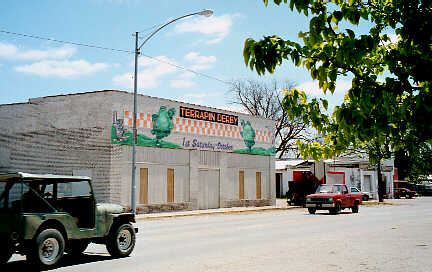

This 10x60-foot mural at the intersection of highways 135 and 140 in Lepanto is the work of Dale Case, former art instructor at Walnut Ridge High School, now assistant principal at Gosnell High School. The mural covers the side of an apartment building and commemorates the WWII exploits of Congressional Medal of Honor winner James R. Hendrix, a Lepanto favorite son, now living in Florida.
The piece was commissioned by the city fathers in 1991 as part of a ceremony marking the fiftieth anniversary of the attack on Pearl Harbor; but the painting was formally dedicated, with Jimmy Hendrix in attendance, the first week in October in conjunction with that year's annual Terrapin Derby.
Yes, Terrapin Derby.  There is a weekend festival in Lepanto the first weekend in October which draws terrapin enthusiasts as well as people who are merely curious about terrapin enthusiasts from hundreds of miles around. A Terrapin Queen is chosen and the usual gamut of festive foods, arts-and-crafts, contests, bluegrass and nongrassy blues are offered in addition to the excitement of the terrapin race itself. As you might expect, the kind of people who watch those races are just there hoping to see a spectacular terrapin pileup; but stringent safety regulations have thus far prevented any terrapin racing fatalities.
There is a weekend festival in Lepanto the first weekend in October which draws terrapin enthusiasts as well as people who are merely curious about terrapin enthusiasts from hundreds of miles around. A Terrapin Queen is chosen and the usual gamut of festive foods, arts-and-crafts, contests, bluegrass and nongrassy blues are offered in addition to the excitement of the terrapin race itself. As you might expect, the kind of people who watch those races are just there hoping to see a spectacular terrapin pileup; but stringent safety regulations have thus far prevented any terrapin racing fatalities.
This advertisement for the event across the top of this building was painted in 1995. It is also the work of Dale Case.
As for Jimmy Hendrix, well, I went and looked up his citation, and on the day after Christmas back in '44, ol' Jimmy was one busy boy. He was a lowly private in the 53rd Armored Infantry Battalion, 4th Armored Division, the lead element of forces driving through Assenois in Belgium trying to relieve the American forces besieged at Bastogne. His column is confronted by two German 88mm guns. He hops out of his halftrack with his trusty rifle, shoots the officer commanding the two guns and captures the eight men serving the weapons.
Not enough fun for Jimmy. Later in the day he spots two wounded GI's pinned down by German machine gun fire. Once again he hops out of his halftrack with his trusty rifle, "suppresses" the machine gun in a way not specified in the citation and delivers the two wounded GI's to safety.
 Still later in the day he spots a GI trapped in a burning halftrack under direct enemy fire in a mined area. (I'll bet you think I'm making this up.) Live ammunition cooks off like deadly popcorn as the raging flames flame and rage through the rage flame thing? Jimmy, braving all the very loud and very obvious dangers, drags the guy from the halftrack, extinguishes his burning clothing, and takes him to safety.
Still later in the day he spots a GI trapped in a burning halftrack under direct enemy fire in a mined area. (I'll bet you think I'm making this up.) Live ammunition cooks off like deadly popcorn as the raging flames flame and rage through the rage flame thing? Jimmy, braving all the very loud and very obvious dangers, drags the guy from the halftrack, extinguishes his burning clothing, and takes him to safety.
The right side of the Dale Case mural depicts private Hendrix's war exploits. The center of the mural shows President Truman awarding the Congressional Medal of Honor to Jimmy, at the time the youngest man ever to recieve the award. The left side of the mural shows scenes typical of the Lepanto area at the time of the second world war.
When I spoke with Dale Case on the phone, he pointed out the consistent use of baroque conventions in this work. For instance there is a tree in the battle scene balancing the tree on the Lepanto side. There is a road on the left that balances a road on the right. The smoke from the burning jeep balances the smoke curling from the stacks of the riverboat. The halftrack balances the riverboat, the jeep balances the log cabin, the train of captured Germans balances the team of mules hauling logs (a thematic reflection as well as a visual one).
He also said that it was a very baroque thing to do to break the plane of the picture, intruding the scene into the viewer's world. He achieves this effect on one side with the dead German's arm hanging out of the frame and on the other side with the cotton plants bulging past the edge of the painting.
RTJ--4/5/98